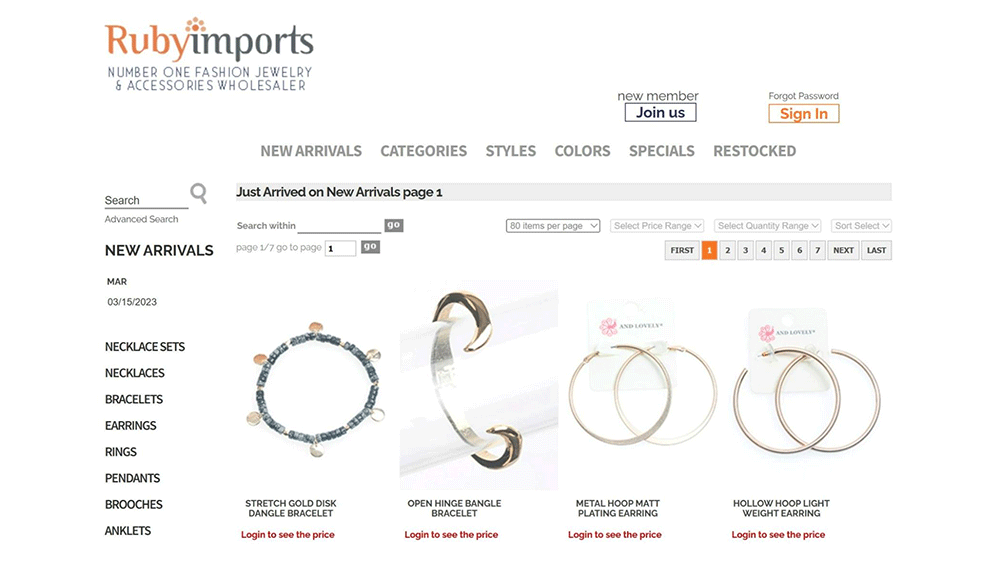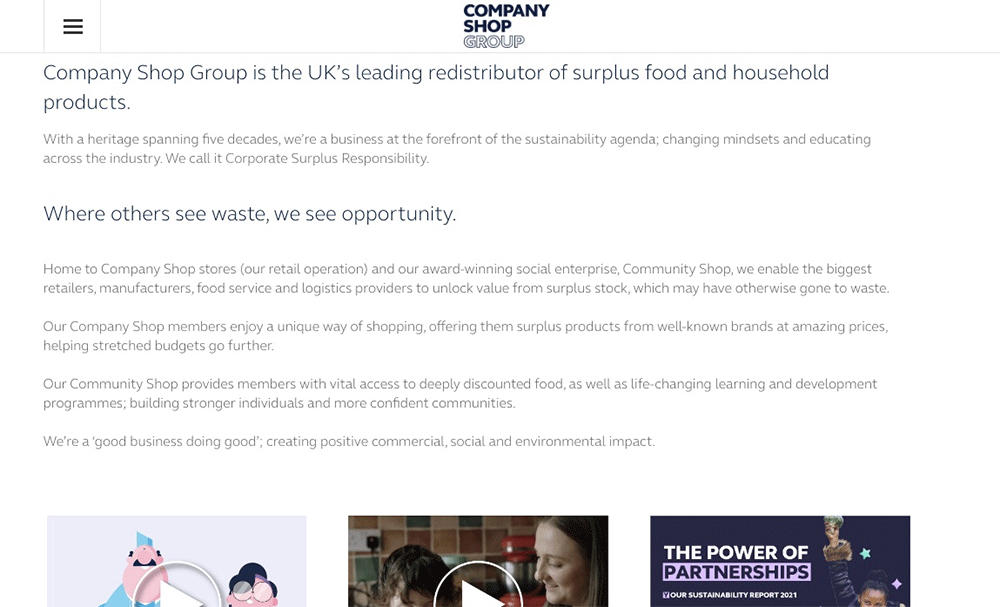Well, first, you’re going to need a plan.
Creating an eCommerce business plan is an essential step that no one should ever skip. It will help you identify your goals, define your target audience, and develop a strategy to meet your objectives.
And it can even help you secure funding to get your business idea off the ground.
Many successful businesses, including big brands like Amazon, started with an eCommerce business plan.
Just look at eCommerce legend Jeff Bezos: In 1994, he worked on Wall Street and saw the potential for selling products online. He raised funding from friends and family by convincing them of the potential profits with his eCommerce business plan.
It’s obvious that the eCommerce industry is still growing rapidly.
There are still plenty of opportunities for you to build a profitable and sustainable online business by following in the footsteps of successful eCommerce businesses and developing a well-thought-out plan.
And that’s precisely what we’ll cover in this guide.
You’ll learn how to create a business plan that sets you apart and gives you the best chance of success and high profits. As a bonus, we’ve also included three high-profit potential business ideas so you can get started right away.
Let’s dive in.
Types of eCommerce businesses
Before we get to the step-by-step, let’s quickly review the types of eCommerce businesses you could start.
The eCommerce market is set to generate $6.5 trillion in 2023, and many different types of businesses contribute to the thriving industry.
1. Online retailing

First up, we have the classic online store. This is like a virtual version of your favorite brick-and-mortar shop.
Shoppers can browse products, add them to their cart, and checkout online. It’s like shopping in your pajamas but without the shame of being seen in public wearing them.
How the business works:
You set up a fancy website with product descriptions and pictures that make shoppers want to buy everything. Then, customers browse the site and add items to their digital shopping cart.
Once they’re done shopping (or their bank account balance tells them to stop), they go to the virtual checkout and pay for their items using various payment options.
You then receive the order, package the items, and ship them to the customer’s doorstep.
What you need to get started:
A website:
You can’t sell your amazing products without a platform to showcase them.
Products:
This might seem obvious, but you can’t sell nothing. You’ll need to determine what you want to sell and source those products from suppliers.
Not sure what to sell? Get some inspiration from our list of 50 Best Dropshipping Products That Will Make Money in 2026.
A catchy name:
Your store needs a name that stands out from the crowd.
A way to accept payments:
You’ll need a way to accept payments from your customers. Luckily, there are many options, from PayPal to credit card processors.
Marketing know-how:
If you build it, they won’t necessarily come. You’ll need to get the word out about your store through social media, ads, and other marketing channels.
2. Private label dropshipping

Private label dropshipping is a way to sell products without having to deal with the hassle of manufacturing, packaging, and shipping.
You find a supplier who creates products but is willing to ship those products to your customers under your own brand and handle the whole fulfillment process.
How the business works:
You find a supplier willing to add your personal touch to the product by adding a label with your store’s branding, colors, and logo when they ship it to the end customer.
You then list the products on your website and start marketing them like crazy. When a customer places an order, your supplier receives the order and ships the product directly to your customer with your branding intact.
You don’t have to worry about keeping inventory or shipping products yourself.
What you need to get started:
A niche:
You’ll want to find a niche that you’re passionate about and has a market demand. This could be anything from fitness gear to skincare products.
A supplier:
You’ll need a supplier to create and ship products under your brand. Look for a reliable supplier with good reviews willing to work with you to create your perfect product.
Your own branding:
This is where the fun begins! You’ll want to create your own branding for your products, including labels, packaging, and marketing materials.
A website:
You’ll need a website to showcase your products and take customer orders.
Marketing know-how:
You’ll need to promote your store and products through social media, ads, and other marketing channels. Get creative and have fun with it!
3. Subscription-based store

Next, we have the subscription-based eCommerce business. These companies offer recurring services or products, like a monthly box of snacks, a curated selection of beauty products, or even a monthly delivery of socks (yes, really).
How the business works:
You offer your customers a subscription to receive your products regularly, whether weekly, monthly, or quarterly. Customers sign up for your subscription service and select their preferences, such as product type, quantity, and frequency of delivery.
Then, you curate and package the products and ship them directly to your customers on a regular basis. This creates a steady stream of recurring revenue for your business and keeps your customers happy with a regular supply of their favorite products.
What you need to get started:
A product:
You’ll need a product people can’t get enough of. This could be anything from gourmet coffee to monthly skincare kits.
A subscription model:
You’ll need to figure out the subscription model that works best for your business, such as monthly, quarterly, or annual subscriptions. You’ll also need to decide on the pricing and perks you’ll offer to subscribers.
A website:
You’ll need a website that showcases your products and allows customers to sign up for your subscription service.
Discover how to boost sales at your store in our Complete Guide to eCommerce Optimization.
A way to curate and ship products:
You’ll need to figure out how you’ll curate and package your products and how you’ll handle shipping and logistics. You can either do it yourself or partner with a fulfillment center.
Marketing know-how:
You’ll need to promote your subscription service to attract and retain customers. Reducing customer churn will be one of your biggest marketing objectives.
4. Dropshipping

The dropshipping model. This is where a business doesn’t actually hold inventory but instead takes orders from customers and then purchases the product from a third-party supplier who then ships the product directly to the customer.
How the business works:
First, you set up an online store and find a supplier willing to dropship their products for you. You then add the supplier’s products to your store and set your own prices.
When a customer places an order, you forward it to the supplier, who then ships the product directly to the customer. So you don’t have to worry about managing inventory or shipping products yourself.
You get to focus on promoting your store, attracting customers, and providing excellent customer service. Plus, you don’t have to buy inventory upfront. So you can test out different products and niches without risking a lot of money.
Does this sound like the right business model for you?
You can learn how to get started in our guide, How to Start a Dropshipping Business in 7 Easy Steps.
What you need to get started:
An online store:
You’ll need a website or an e-commerce platform to showcase your products and process orders.
A reliable supplier:
You’ll need to find a supplier willing to dropship their products for you. Do your research and find a supplier who offers quality products and reliable shipping.
Products to sell:
You’ll need to choose products you want to sell in your store. Finding a niche you’re passionate about and selecting products in high demand is essential.
Marketing know-how:
You’ll need to promote your store and drive traffic to your website. This could involve social media, SEO, or even paid advertising.
Customer service skills:
You’ll need to provide excellent customer service and handle any issues that may arise. Remember, happy customers are the key to success!
5. eCommerce marketplaces

An eCommerce marketplace is like a digital shopping mall, where multiple vendors come together to sell their products on a single platform. It’s like having your own little storefront in a bustling virtual bazaar.
How the business works:
You find a platform to list and sell your products. Customers can browse through your marketplace store and purchase products.
As a vendor, you get access to a large audience of potential customers without worrying about setting up your own eCommerce website.
The marketplace owner typically takes a percentage of each sale as a commission, while the vendors handle the fulfillment and shipping of their own products.
What you need to get started:
Products:
You’ll need to decide what products you want to sell and ensure they meet the marketplace’s guidelines. It’s important to do market research on what products are popular and in demand.
Check out our list of 30 of the Best Low Cost, High-Profit Products to find a winning line for your business.
A platform:
You’ll need to find a platform to list and sell your products.
A store:
Once you’ve registered, you’ll need to set up your store. This will involve creating a profile, uploading product images, and writing descriptions.
Marketing know-how:
To be successful in an eCommerce marketplace, you’ll need to invest in marketing your products. This could involve advertising on the marketplace, social media, or other channels.
Customer service skills:
Finally, you’ll need to provide excellent customer service. Respond to customer inquiries promptly, process orders quickly, and resolve any issues.
6. Social commerce

Now, we have the social commerce model. This is where social media platforms are used to sell products directly to customers.
So instead of scrolling through cat videos and memes, you can now buy that cat-shaped phone case you’ve been eyeing. It’s like online shopping and social media had a baby.
How the business works:
The social commerce business model is all about using social media platforms to sell products directly to customers.
As a business owner, you’ll need to set up a social media account on platforms like Instagram, Facebook, or TikTok. This is where you’ll showcase your products, interact with customers, and drive sales.
When a customer sees a product they like, they can make a purchase directly through the social media platform. Some platforms have built-in shopping features, while others require customers to click a link to an external website.
Once the customer makes a purchase, you’ll need to process the payment and handle shipping. Some social media platforms offer built-in payment and shipping options, while others require you to handle this on your own.
What you need to get started:
A product:
You’ll need a product to sell. This could be something you make yourself, source from a supplier, or dropship.
A social media account:
You’ll need to set up a social media account on a platform that makes sense for your business. Instagram marketing, Facebook ads, and TikTok are all popular options.
Great visuals:
Social media is all about eye-catching visuals, so you’ll need to invest in high-quality photos and videos of your products. You might take these yourself or hire a professional photographer.
Discover more ways to boost sales and strengthen your brand in our list of 19 of the Best eCommerce Strategies for Today and Tomorrow.
Payment and shipping systems:
You’ll need to have a way to process payments and handle shipping. Some social media platforms have a built-in payment and shipping features, while others might require you to use third-party services.
A social media strategy:
Finally, you’ll need a plan for using social media to promote your products and engage with customers. This might involve posting regular updates, collaborating with influencers, or running paid advertising campaigns.
7. Wholesaling

eCommerce wholesaling is all about buying products in bulk from manufacturers and selling them to retailers or other businesses at a discounted price.
Think of it as buying a big bag of candy from the store and then selling individual pieces to your friends for a profit (except in this case, the candy is more practical, like office supplies or electronics).
How the business works:
You buy products in bulk from manufacturers at a discounted price. Then, you sell those products to retailers or other businesses at a higher price, making a profit.
Let’s say you’re selling office supplies. You might buy a whole bunch of pens, paper clips, and staplers from a manufacturer at a lower cost per unit than a retailer would pay. Then, you sell those products to retailers at a slightly higher price, but still lower than what they would pay if they bought directly from the manufacturer.
What you need to get started:
Negotiating skills:
You’ll need a big ol’ bag of business savvy and a knack for negotiating deals. You’ll also need a solid understanding of the products you plan to sell and the market demand.
Negotiating lower pricing with suppliers is one of the best ways to boost profits during an economic downturn. Check out our guide, 10 Proven Strategies to Grow Your eCommerce Business During a Recession, to discover the other ways you can thrive when consumers tighten their belts.
Suppliers:
You’ll need to find reliable suppliers who can provide quality products at a discounted price. You can search for manufacturers online, attend trade shows, or even ask around in your industry to find the best suppliers.
Storage space:
Once you have your suppliers lined up, you’ll need a place to store all the products you will buy in bulk. You can rent a warehouse, set up a garage or basement storage area, or even use a fulfillment center specializing in eCommerce wholesaling.
Marketing know-how:
You’ll need to find ways to promote your products and attract customers to your eCommerce business. This could involve creating a social media presence, running targeted ads, or networking with other companies in your industry.
Want to know more about the different types of eCommerce businesses and how they work? Check out our detailed guide to learn more.
Step-by-step process of how to write a business plan for an ecommerce store
Starting an eCommerce business can be exciting, but it can also be overwhelming. You’ll find it much easier if you have a plan to follow.
In this section of the guide, we’ll reveal the step-by-step process of writing a business plan for an eCommerce company.
If you’re new to eCommerce and want to know more about the basics and how to get started, check out our guide, How to Start Selling Online from Home (and Actually Make Money).
The executive summary is the first section of your eCommerce business plan. It should provide an overview of your business, including your mission statement, goals, and objectives.
Here’s a great example from the Company Shop Group:

Your executive summary should also include an overview of your products, target market, and marketing strategies. There is a lot to cover, but keep this section brief and concise.
You can go into more detail in the following sections.
In this section, you should provide a detailed description of your eCommerce business. This should include your business structure, legal status, location, and the products or services you will offer.
You should also include details about your management team, their experience, and their roles in the company.
Now it’s time to analyze your target market and the competition. You should provide information on the size and characteristics of your target market, their needs and preferences, and the potential demand for your products.
You should also provide a detailed competitive analysis. This should include the strengths and weaknesses of your competitors and how you plan to differentiate yourself. A competitive analysis in this scenario is defined as a systematic evaluation of industry peers, involving the thorough examination of their market strategies, product portfolios, financial performances, and operational approaches. This method provides businesses with crucial insights into the competitive landscape, enabling them to identify opportunities, mitigate risks, and formulate effective strategies to enhance their market position and overall competitiveness.
You can even create a SWOT Analysis, which in the context of eCommerce, entails examining the strengths, weaknesses, opportunities, and threats - i.e the internal facets such as the company's competitive edge, operational efficiency, and market positioning, while also scrutinizing external factors like market trends, competitor strategies, and regulatory changes. By dissecting these elements, eCommerce enterprises can pinpoint their core strengths, areas for improvement, potential growth avenues, and imminent risks. This strategic assessment empowers them to devise tailored strategies that harness strengths, mitigate weaknesses, exploit opportunities, and navigate threats effectively within the dynamic eCommerce ecosystem.
This section should provide a detailed description of your products. You should include information on the features and benefits, pricing strategies, and any unique selling points.
You should also outline your product development process, including how you will source and manufacture your products.
The SaleHoo Directory is the perfect place to look for suppliers.
And you can check it out risk-free with our 60-day money-back guarantee.
In this section, you should outline your marketing and sales strategies. This should include your branding strategy, social media strategy, email marketing strategy, and any other marketing channels you plan to use.
You should also outline your sales strategy, including your pricing, sales channels, and targets.
If you are unsure what data you should be tracking and what your targets should be, check out our guide, 9 eCommerce Metrics That Will Help You Run a More Profitable Online Store.
The financial plan is one of the most critical sections of your eCommerce business plan. This should include a detailed financial analysis, including your startup costs, projected revenue, and expenses, cash flow projections, and break-even analysis.
You should also include any funding requirements, such as loans or investments, and how you plan to use the funds.
Now, it’s time to outline your eCommerce logistics and operations plan, including your website design and development, order fulfillment process, customer service strategy, and other operational processes. You should also include details on your suppliers and vendors and any legal and regulatory requirements.
The management and organization section should provide information on your team and organizational structure. You should include details on your key personnel, their roles and responsibilities, and their experience in the industry.
The conclusion should summarize your eCommerce business plan and highlight the key points. You should reiterate your mission statement, goals, objectives, and any unique selling points.
Bonus: 3 high-profit ecommerce business examples
So that’s our step-by-step guide on creating an eCommerce business plan.
But we’re not done yet.
As a bonus, we’ve also compiled three high-profit business ideas to inspire you.
Business idea 1: Clean beauty box subscription
In this business model, you could curate and deliver monthly boxes of high-quality, non-toxic, organic beauty products to subscribers. The subscription service could offer different box sizes and options, such as skincare-only or makeup-only boxes, to appeal to a wider range of customers.
Potential profit:
While the potential profits will depend on factors like the cost of goods, pricing, and your business strategy and marketing plan, it has the potential to be highly profitable if executed properly.
You can generate recurring revenue and build a loyal customer base by offering a subscription-based service. It can be highly profitable, especially if you can keep your costs low and provide value to your subscribers by offering unique products that are not easily available in regular stores.
How to start this business:
To start this business, you would need to research and source a variety of clean beauty products from different suppliers and wholesalers.
Then, you’ll need to create a website to showcase your subscription service and allow customers to sign up and manage their subscriptions. You’ll also need to establish partnerships with shipping companies to ensure the timely delivery of the beauty boxes.
Marketing will also be vital to reaching your target audience through social media, influencers, and other digital channels. You’ll also need to offer exceptional customer service and maintain a high level of quality for your beauty boxes to retain subscribers.
Business idea 2: Ethical fashion social commerce
Another potential business idea for a social commerce brand is to create a line of sustainable and ethical fashion products marketed and sold primarily through social media. This could include using environmentally friendly materials, supporting fair labor practices, and minimizing waste and carbon emissions throughout the supply chain.
Potential profit:
There is huge potential for a sustainable and ethical fashion social commerce brand to generate significant profits. According to a report by McKinsey & Company, there is a growing demand for sustainable fashion among consumers.
Younger generations are willing to pay more for products that align with their values. In addition, social media platforms provide a unique opportunity to market and sell products directly to consumers, which can reduce overhead costs and increase profit margins.
How to start this business:
You’ll need to build a strong social media presence on platforms such as Instagram, Facebook, and Pinterest. Use visually appealing content, including high-quality images and videos, to showcase your products and brand values.
Partnering with influencers and micro-influencers in the sustainable fashion niche to promote your brand and products to their followers could be an excellent way to increase your reach. Consider offering them exclusive discounts or free products in exchange for featuring your brand on their social media accounts.
Use social media as your primary sales channel by integrating shopping features directly into your posts and stories. This could include tagging products in your posts or adding swipe-up links to your stories that take users directly to your online store.
Offer exceptional customer service and a seamless online shopping experience to build customer loyalty and generate positive reviews and referrals. Consider implementing a loyalty program that rewards customers for repeat purchases and social media engagement.
Business idea 3: Wholesaling massage equipment
Wholesaling massage equipment can be lucrative, especially considering the growing demand for wellness products and services. Your target market will be massage therapists, spas, and other wellness eCommerce businesses that offer massage equipment.
Potential profit:
The massage industry is predicted to generate $19 billion in the US alone in 2023. So it’s a sizeable growing market you can tap into.
The amount of profit the business can make depends on multiple factors. But you could generate significant profit if you have a competitive pricing strategy and offer high-quality products. That's why it's always important to think about pricing when running a competitive analysis for your business.
A wholesaler’s average profit margin is less than a retailer’s, but you’ll be turning over much larger quantities of products per sale.
How to start this business:
Look for reliable suppliers that can provide quality massage equipment at competitive prices. You can connect with manufacturers to find potential suppliers.
You’ll need more funds to get this business idea off the ground, so determine how much capital you’ll need and explore funding options such as loans, grants, or investors.
Establish relationships with massage therapists, spas, and eCommerce store owners to create a strong network. Attend industry events, participate in social media groups, and offer promotions to attract new clients.
Putting your ecommerce business plan into action
There’s no better time to start an eCommerce business. And with a good business plan, you’ll increase your chances of success and speed up growth.
But you’ll need reliable suppliers no matter which type of eCommerce business you choose to start. That’s where the SaleHoo Directory comes in.
You can find millions of products from over 8,000 vetted and trustworthy suppliers. Sign up and start contacting reliable suppliers today.
And if you have any questions about eCommerce, don’t hesitate to contact our 24/7 customer support team.











